18 Types of Ducks in Alaska (With Pictures)
Last Updated on
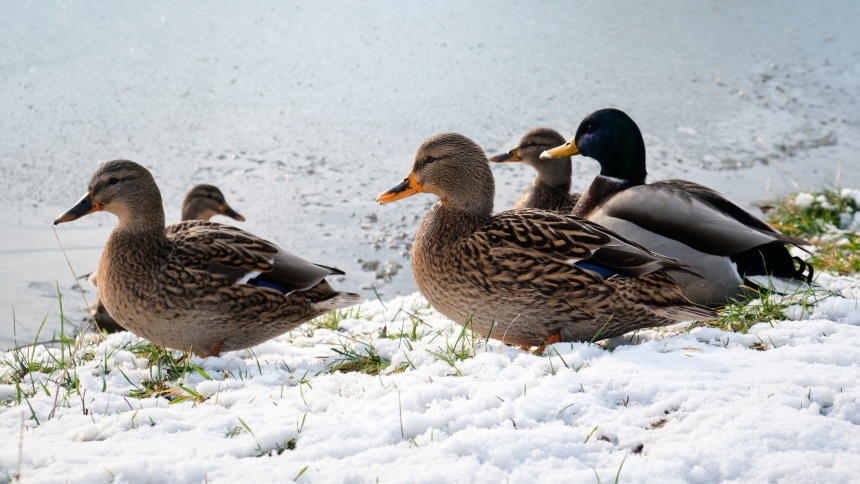
Head to any water habitat in Alaska, and you are almost guaranteed to see a few ducks. While you might think that a duck is just a duck, you’ll be surprised at just how many species of ducks make their home in the northern state. With so many species of ducks migrating in and out of Alaska throughout the year, it would be impossible to make a complete list of all the ducks that you might see.
So, this article features the most common ducks in Alaska and the ones that you are most likely to see. Since there are two different types of ducks, we organized this list into two subcategories:

The 18 Types of Ducks in Alaska
- Diving/Sea Ducks: Diving or sea ducks completely submerge themselves underwater to catch their food, whether aquatic vegetation or fish and invertebrates. This type of duck has narrower, pointier, and smaller wings than other ducks because they are designed for swimming. While these ducks are adept swimmers, they typically lack the ability to take off into flight from the surface of the water like dabblers do. Diving ducks commonly run along the water surface to build up enough speed to become airborne.
- Dabbling Ducks: Dabbling ducks or dabblers catch their food by sticking just their heads under the water surface. These are the ducks that you see with their tails sticking up out of the water as they graze. Dabblers also eat seeds and waste grain in farm fields in the early spring once the snow melts.
Diving Sea Ducks
1. Bufflehead Duck
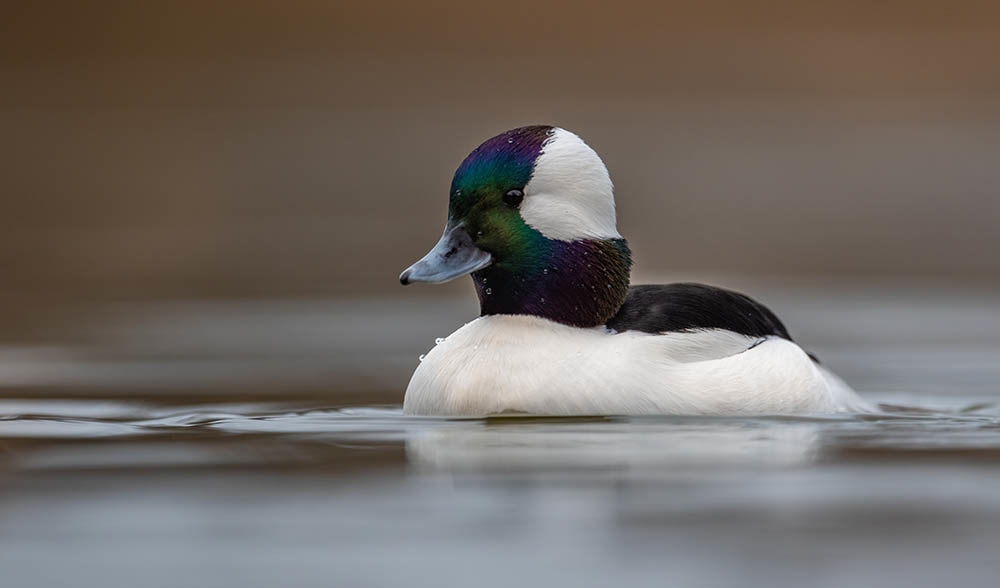
- These are small-bodied ducks with large heads.
- Males have white flanks and chests with large white patches on their heads. They have iridescent purple and green feathers on their faces.
- Females are mostly brown with dark heads. They have distinctive white patches of feathers on their chests.
The Bufflehead duck spends up to half their time foraging underwater, searching for crustaceans and other aquatic invertebrates.
They are picky nesters and will only lay their eggs inside a cavity. They can be found almost exclusively inside holes excavated by Northern Flickers and sometimes those created by Woodpeckers. Logging operations have caused this species to lose their natural nesting sites, but they have adapted well to man-made nesting boxes.
Buffleheads are quiet ducks, but males do make squeaky whistling sounds in late winter and early spring.
2. Redhead Duck
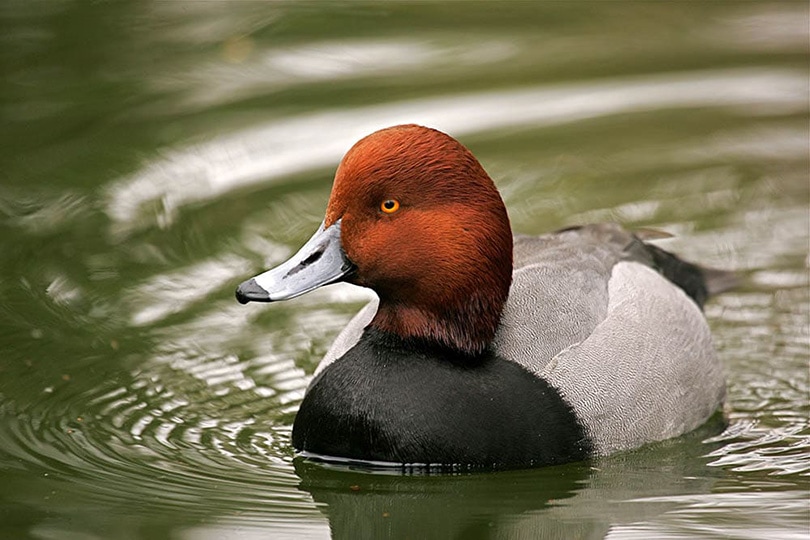
- These ducks have steep foreheads and black-tipped gray bills.
- Males have red cinnamon heads and yellow eyes.
- Females are brown with dark eyes.
Redheads are among the more sociable species of ducks that you’ll find in Alaska, particularly in the winter. They gather in enormous flocks of thousands of ducks on large lakes. As social ducks, they are easily drawn to decoys and therefore, are popular targets for hunters.
Female Redheads practice brood parasitism, meaning they lay their eggs in nests of other duck species and let those females raise their young. Targeted species include Mallards, Canvasbacks, Northern Pintails, Gadwalls, Ruddy Ducks, and American Wigeons. Interestingly, they only do this with some of their eggs, while retaining a few to raise themselves.
During the breeding season, males make catcalls to females. They also make low growls when they feel threatened.
3. Canvasback Duck
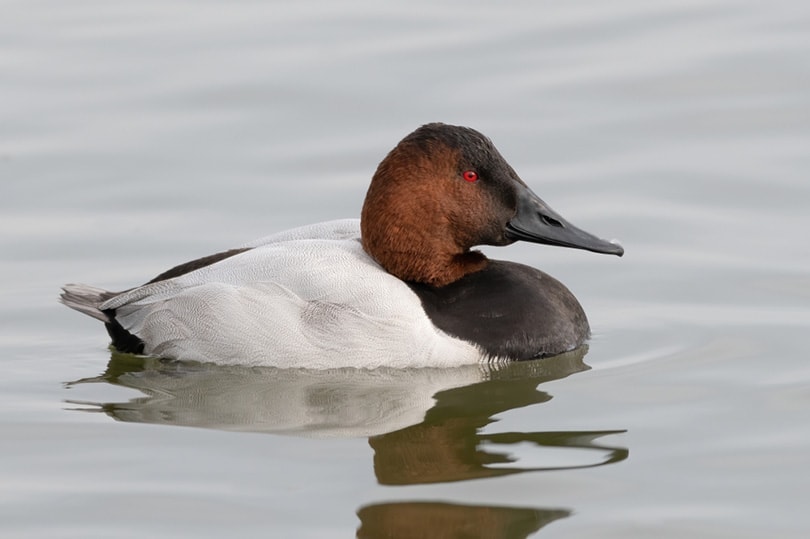
- This is a large diving duck with a black breast and tail and a pale gray wedge-shaped head that slopes down to a long bill.
- Males have reddish-brown heads with red eyes.
- Females are a duller color overall, with brown heads and black eyes.
Canvasbacks rarely ever move to dry land, so you’ll need to be next to a water body to find them. They build their nests in floating vegetation and even sleep while floating on the water.
As omnivores, these ducks will eat everything from plants and seafood to insects. They are capable of diving up to 7 feet to rip out aquatic plants with their bills, but wild celery is their primary food source.
4. Common Goldeneye Duck

- Males have dark green heads, yellow eyes, and white cheeks.
- Females have brown heads and dark bills with a yellow tip.
Common Goldeneye ducks are expert divers. They can stay underwater for a full minute while scanning for prey, which is predominantly fish, fish eggs, and submerged vegetation.
These ducks nest in cavities, so the survival of the species depends on forestry practices that don’t cut down dead trees. They do well in artificial nest boxes put up for them during the breeding season.
The Goldeneye duck is commonly referred to as “the whistler” due to the distinct whistle that their wings make in flight.
5. Ring-Necked Duck Duck

- This is a medium-sized duck with a peaked head.
- It has a gray bill with a white stripe and black tip.
- Males are glossy black with yellow eyes.
- Females are brown with gray faces and throats.
Ring-Necked is a misnomer when it comes to identifying this duck species. While you would expect a ring around their neck, the ring is, in fact, around their bill — at least, the one that you can see is. There is a “ring” of sorts located on their neck, but it’s so pale that it’s impossible to spot unless you’re right next to them.
Ring-Necked Ducks like to inhabit shallow wetlands. They gather in large flocks in winter but only hang out in pairs during the breeding season. These ducks have a penchant for eating leftover shotgun pellets after hunting season, which makes them at high risk for developing lead poisoning. Lead shot was banned in Alaska in 1991, which has helped maintain population numbers, but some old ammo still remains in use.
6. Red-Breasted Merganser Duck

- These are slim ducks with long bodies.
- Breeding males have dark green heads with spiky crests and red eyes.
- Females and non-breeding males are greyish-brown.
Red-Breasted Mergansers are native to boreal forests and inland lakes all across North America. They migrate south for the winter, but it’s possible to find them year-round on any unfrozen water body.
Merganser duck breeds have particularly distinctive, bright-colored crests that make them easy to identify. Interestingly, their crest is only present in breeding males, as non-breeding males take on primarily female characteristics. This trait is specific to Merganser duck breeds.
Fish are the Red-Breasted Mergansers’ primary food source. These ducks can consume about 15–20 fish per day to meet their energy demands. To do this, it’s estimated that they make approximately 250 dives a day. They have been known to work together by herding minnows into shallow water, making them easier to catch.
Non-duck hunters might find it interesting to know that Mergansers are not birds that are hunted. Birds that eat fish taste horrible and are therefore not sought out as food sources.
7. Hooded Merganser Duck
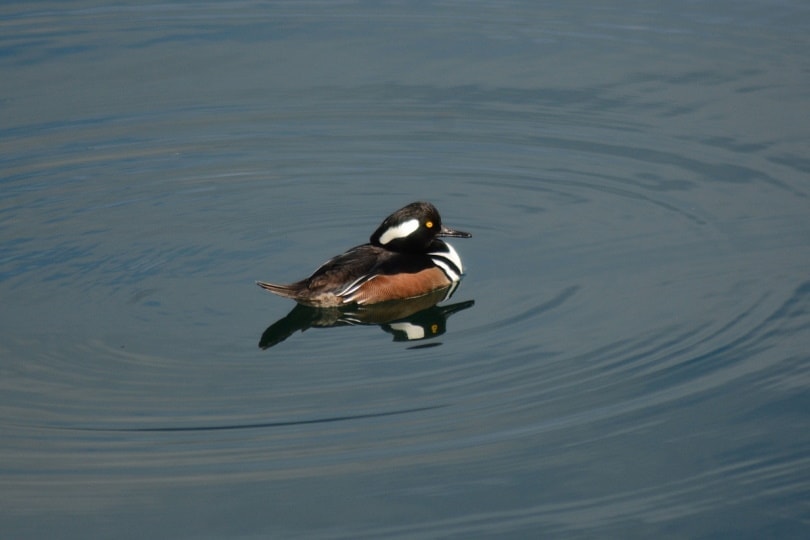
- This is a small duck with a slender bill.
- A breeding male has a large black crest with white patches on each side.
- Males have yellow eyes.
- Females have light-colored crests comparable to mohawks and dark eyes. Non-breeding males look similar to females except with yellow eyes.
Once you lay eyes on a Hooded Merganser, you won’t forget it. They are beautiful birds with distinct features. Just like the Red-Breasted Merganser, the distinctive crest is only found in breeding males, while the non-breeding males look like females.
This duck species has a serrated bill to help them catch fish and insects. They almost always swallow their food whole. Since they hunt by sight, they have adapted vision that enables them to see clearly underwater.
Females lay some of their eggs in their own nests while laying others in the nests of other female Hooded Mergansers. While they only lay up to a dozen eggs at a time, some females can be found with up to 40 eggs in their nests, so those ducks work much harder than others!
8. Common Merganser Duck
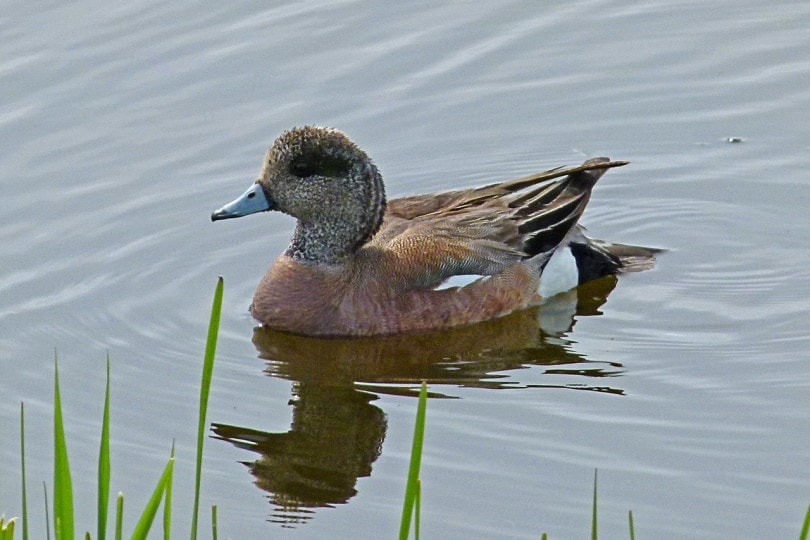
- These are large ducks with slender orange bills with black tips.
- Breeding males have white bodies, black backs, and green heads (similar to mallards).
- Females and non-breeding males have grayish-white bodies and light brown heads.
Common Mergansers are fairly easy to spot due to their distinctive thin bills. Like other Merganser species, these birds eat fish that they catch with their serrated bills. These ducks are such good fishers that it’s not uncommon to see them being stalked by flocks of seagulls trying to steal their catch. Even Bald Eagles have been known to steal their food.
Woodpeckers provide nesting grounds for the Common Merganser, as they nest in carved-out tree cavities. Ducklings leap to the ground at only 1 day of age and are then led to the water by their mother to start fishing.
9. Greater Scaup Duck

- Males have yellow eyes, green heads, and speckled black and white sides.
- Females are chocolate brown with darker heads. They also have white feathers at the base of their bills.
- The bills of both sexes are blue-grey with black tips.
Greater Scaups spend their summers breeding in the extreme far north of the Arctic. Some of these ducks cross the North Pole into Northern Europe to breed, while others remain in Alaska, the Yukon, and the Northwest Territories.
These ducks are difficult to distinguish from Lesser Scaups, except for their green heads.
10. Lesser Scaup Duck

- Males have yellow eyes, black heads, and speckled black and white sides.
- Females are dark brown with bright-white feathers at the base of their bills.
The most common diving duck species in North America is the Lesser Scaup. That said, it’s not easy to see one. These ducks gather in flocks of thousands of birds and swim so close together that they look like large masses of floating vegetation.
Lesser Scaups look similar to Greater Scaups and can only be differentiated by their heads. A Lesser Scaup has a tall, peaked head, whereas the head of a Greater Scaup is rounded.
11. Harlequin Duck Duck
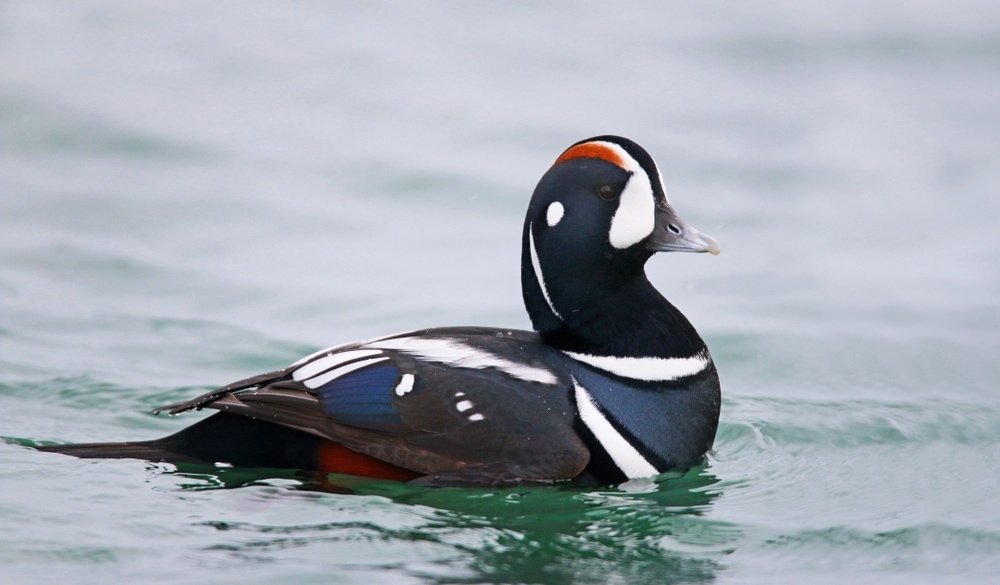
- These are small ducks with gray bills.
- Breeding males have dark blue bodies with rusty red patches and bold white striping around their necks and faces.
- Females are brown with white spots behind their bills and eyes.
Male Harlequin Ducks are a sight to behold. They have a spectacular coloring that looks like it was painted on with a brush. What’s also interesting about this duck species is their choice of habitat. While most diving ducks live in large lakes or reservoirs, the Harlequin makes its home next to fast-moving rivers. It moves to rocky ocean shores with high winds and big waves during the winter.
X-rays of deceased ducks have shown how beat up the bodies of Harlequin Ducks get from being tossed around in extreme weather. Most of them have multiple healed fractures from being slammed around on the rocks.
Harlequin Ducks are extremely vocal, but they don’t sound like ducks. Rather than “quacking” or “honking,” these guys sound like squeaking mice, leading to their nickname, the “Sea Mouse.”

Dabbling Ducks
12. Mallard Duck
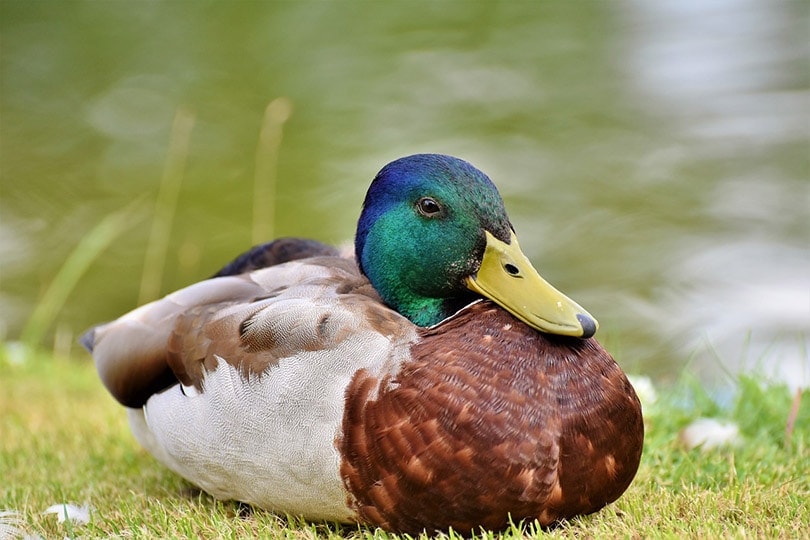
- Males have bright green heads, black rumps, and white-tipped tails.
- Females are mottled brown with black and orange bills.
- Both males and females have purplish-blue secondary feathers on their wings, visible when standing or flying.
The Mallard Duck is the most common duck species found in Alaska and one of the most well-known. Mallards love people and can be found in virtually any wetland habitat in North America. They are even happy to make their home in backyard swimming pools.
The adaptability of the Mallard duck is incredible. They will readily make their home in artificial nesting areas, and many people put them up in their yard so they can enjoy watching Mallard ducklings roam around.
The traditional “duck quack” definitely originated from a female Mallard; no other duck species makes a better duck sound. Interestingly, male Mallards don’t quack.
13. American Wigeon Duck
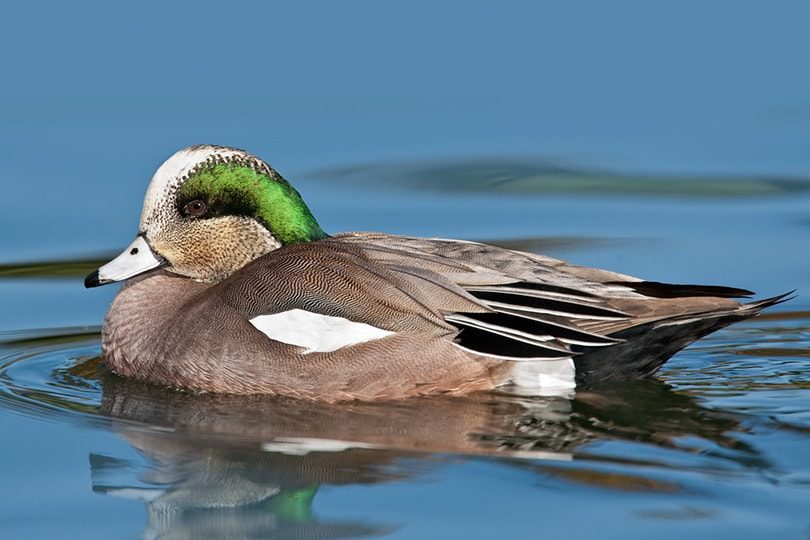
- These ducks have round heads with almost no necks.
- They have blue-gray bills with black tips.
- Males are brown with green bands behind their eyes and white crowns.
- Females are brown with gray heads.
While the American Wigeon population is thriving in Alaska, these ducks are shy and prefer marshlands located far away from people. These ducks feed like geese and are happy to move inland to feed off of farm field waste.
The American Wigeon scares easily when approached, but sometimes, you can hear them. Males have a distinguishable three-beat nasal whistle that sounds similar to a kazoo.
14. Northern Pintail Duck
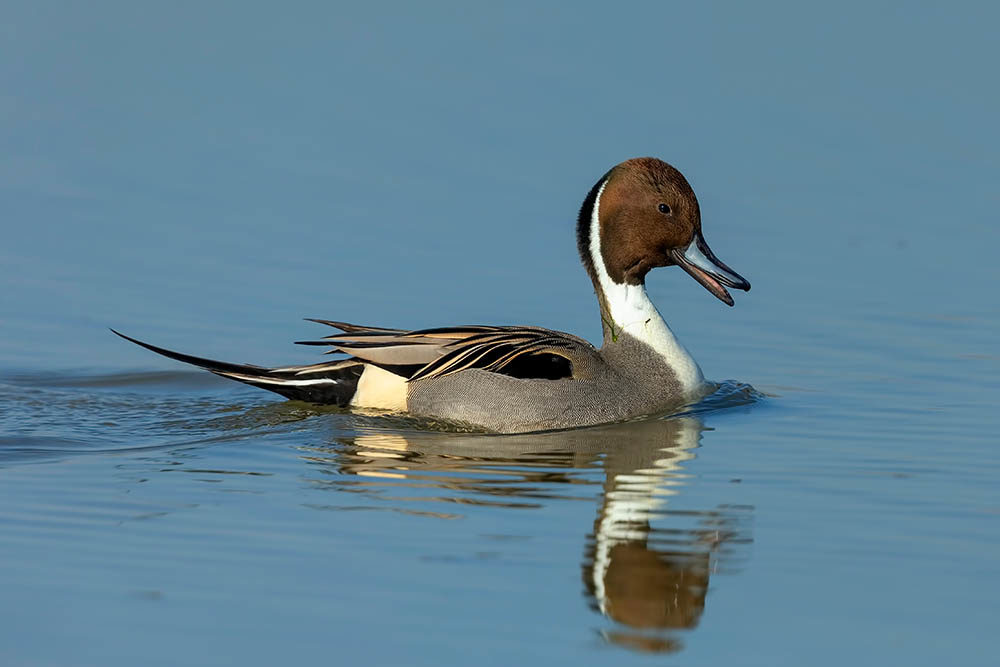
- These ducks have long necks with black-gray bills.
- Males have white throats and chests.
- Females have tan heads with brown body feathers.
The Northern Pintail has a long, pointed tail that is exaggerated by its long neck. Even while floating, its tail sticks out noticeably, which is how this duck species got its name.
The call of the Northern Pintail is reminiscent of a train whistle. You’ll find these ducks in remoted wetlands with shallower waters or scavenging farm fields farther inland.
15. Gadwall Duck

- Males are a mix of gray, brown, and black with dark bills.
- Females look similar to female Mallards, with dark orange and black bills
- White patches on their wings are visible when they’re in flight.
Gadwall ducks are rather generic-looking. They don’t have bright feathers, and they have a reputation for scavenging from other ducks. American Coots are their favorite victims, but any diving duck is a target. They wait for them to surface before stealing their catch and taking off.
If you hear a duck “burp,” you’ve likely found a male Gadwall. While they aren’t actually burping, this is exactly what a Gadwall call sounds like.
16. Northern Shoveler Duck

- These ducks have distinctive large and wide bills.
- Males have reddish-brown sides and yellow eyes.
- Females have blue patches on their shoulders.
Northern Shovelers have enormous spoon-shaped bills that are hard to miss. Their name comes from their ability to use their bill to “shovel” or sift through mud and sand for food. Over 100 tiny projections on this bill help them filter the dirt from their food.
These ducks work in teams to stir up the water and bring food to the top. You will find flocks of ducks swimming in circles when they do this.
17. Blue-Winged Teal Duck

- Males have blue-tinged heads with white patches in front of their eyes.
- Females are mostly brown with dark patches next to their eyes.
Blue-winged teals are named for the beautiful blue plumage on their shoulders that is only visible while these ducks are in flight. They also have green feathers below the blue ones.
The Blue-Winged Teal is the second most abundant duck species in North America, topped in population numbers only by the Mallard. Teals are popular species for duck hunters, but the number of ducks that can be hunted each year is carefully regulated to ensure that the population stays healthy.
18. Green-Winged Teal Duck
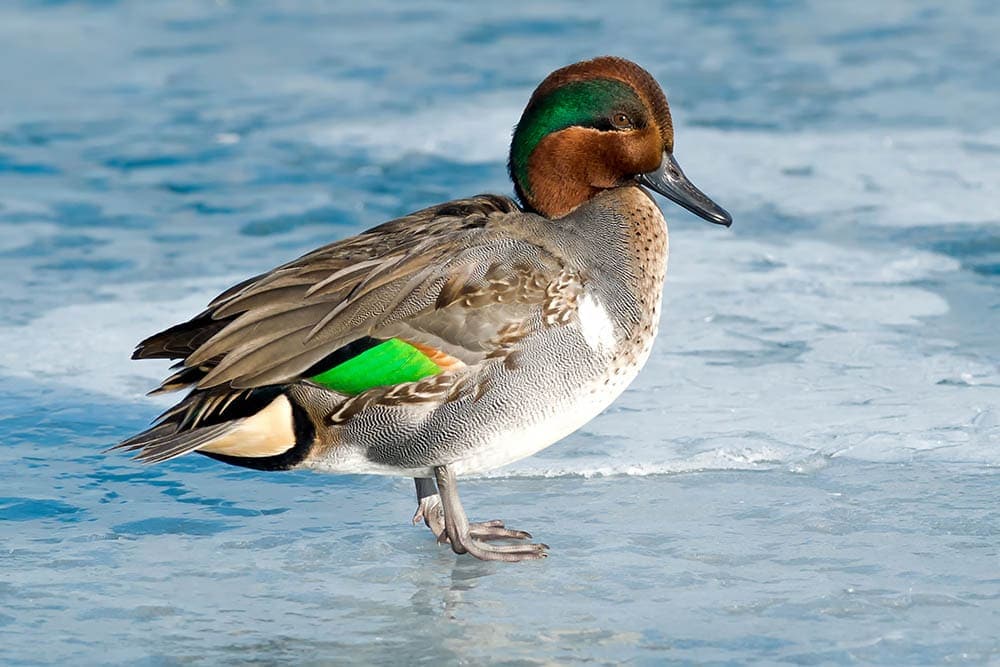
- Green patches appear on the wings of both males and females, visible at rest and in flight.
- Males have green ear patches and brown heads.
- Females are mottled brown over their entire body, with the exception of their green wing patches.
The smallest dabbling duck in Alaska is the Green-Winged Teal. These ducks are a mere 15 inches (39 cm) in length and weigh between 3 and 5 ounces (140–500 grams).
These birds travel with other duck species and can be spotted as the smallest ducks within a mixed flock.
While the Green-Winged Teal is the second most hunted duck in North America, its population continues to increase. Since their breeding grounds are located in the northernmost parts of the state, they haven’t suffered habitat loss like many other species.

How Many Duck Species Live in Alaska?
Alaska is home to over 174 million acres of wetland that provides habitat and breeding grounds for 36 different species of waterfowl. This includes geese, ducks, swans, and several subspecies that aren’t found anywhere else in North America.
Over 1.5 million geese belonging to six species nest in Alaska each year, one-third of all Northern Pintails, and 100% of the North American population of sea ducks breed there. There are also two species of swans, comprising approximately 170,000 individual birds that nest in the state.

How Do You Identify a Duck?
Ducks are a difficult waterfowl to identify because there are so many species and many species flock together. Females (or hens) are even harder to differentiate because they look so similar. Many species of ducks even mate with each other to create hybrid breeds, making identification more difficult.
That said, there are a few characteristics to take note of when you’re trying to identify a duck:
- Size
- Head markings, shape, and size
- Bill color, shape, thickness, and length
- Neck length and coloration
- Plumage (which colors are most prominent, and where are they located?)
- Legs (does the duck walk well on land, or is it more adept at swimming?)
- Tail length and how it’s held
Male ducks, or drakes, will always be easier to identify by sight alone. If you’re trying to identify a hen, you may need to use more than sight to identify the species. In this case, you can also use:
- Sounds — Not all ducks quack, and the ones that do quack don’t all quack the same.
- Flocks — While ducks do travel in mixed flocks, most species will congregate with those of their own kind, giving you more than one duck to identify.
- Feeding behavior — Narrowing down whether you have a dabbling duck that “tips” in the water to feed or a diving duck that disappears underwater will shorten the list of possible species.
- Habitat and Range — Where you are geographically can also narrow down what species of duck you’re looking at, and so can knowing the depth of the water and whether it’s saltwater or freshwater.

Conclusion
Ducks in Alaska can be separated into diving ducks and dabbling ducks. Numerous duck species claim their summer breeding grounds in Alaska, making it ideal for bird watching. While many duck species can be found in Alaska, this list has the 18 most common ones. Their identifying characteristics will give you a better idea of what duck you’ve found or how to spot them in your search.
Featured Image Credit: Jahor, Shutterstock
About the Author Chelsie Frasier
Chelsie is a freelance writer who is passionate about pets, animals and all things optical. She currently lives in rural Alberta, Canada with her husband and two sons, and is a pet parent to a Border Collie, four cats and four horses.
Related Articles:
Monocular vs Telescope: Differences Explained (With Pictures)
10 Types of Hummingbirds in Arkansas (With Pictures)
8 Types of Hummingbirds in Nebraska (With Pictures)
5 Types of Hummingbirds in Idaho (With Pictures)
3 Types of Hummingbirds in Mississippi (With Pictures)
8 Types of Hummingbirds in Kansas (With Pictures)
5 Types of Hummingbirds in West Virginia (With Pictures)
5 Types of Hummingbirds in Ohio (With Pictures)
